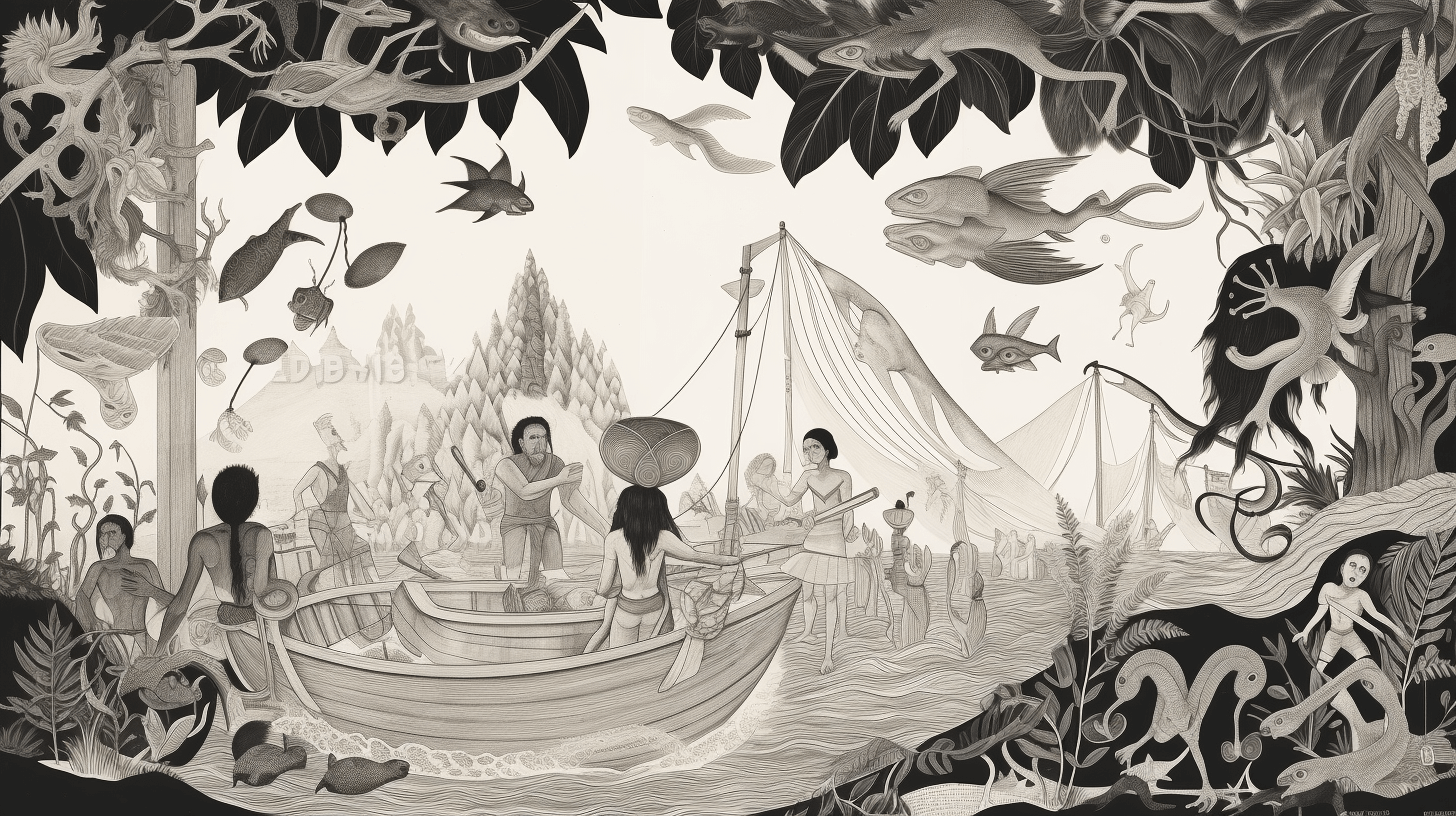🍖🔪💀 Cannibalisms; A Study
⬇️ Pidgin | ⬇️ ⬇️ English
Wen Wan Recent Study Show How Our Ancient Ancestas Used To Chow Down On Each Odda. But Udda Scientists Stay Not Convinced, Say ‘Clickbait’ Fo’ Paleoanthropology? 🤔📚
Everybodi Stay So Quick Fo’ See Kanibal. Da Romans Thought Dem Ancient Britons Stay Eat Human Meat, An’ Da Brits Thought Da Same ‘Bout Da Irish. Plenny Prehistoric Finds Get Labeled As Kanibal Work, Even If Da Labels Not Quite Accurate. In 1871, Mark Twain Wen Comment On Da Discovery Of Bones From One Ancient Man Who Supposedly Get Made Into One Meal By His Peers: “I Gotta Ask Da Honest Reader, No Look Like Dis Guy Get Taken Advantage Of, He Been Dead Fo’ Two Million Years?”
In Da World Of Paleoanthropology, Peeps Stay Looking Fo’ Solid Evidence Fo’ Claim Kanibalism. So, Wen Dis Recent Study Came Out In Scientific Reports, Saying One Piece Of Shin Bone, Dat 1.45 Million Years Old, Was Evidence Dat Our Ancestas Not Only Butchahed Each Odda, But Dey Was Probably “Chowing Down” On Dem As Well, Plenny Eyebrows Wen Go Up. 🤨🦴
Da News Release Claim Dis Da “Oldest Decisive Evidence” Of Such Behavior. Dr. Briana Pobiner, One Paleontologist From Da Smithsonian’s National Museum Of Natural History, An’ Da Main Author Of Da Study, Said In Da News Release, “Da Information We Get Tell Us Dat Our Ancient Ancestas Was Likely Eating Each Odda At Least 1.45 Million Years Ago. We Get Plenny Udda Examples Of Different Species In Da Human Evolutionary Tree Eating Each Odda Fo’ Nutrition. But Dis Fossil Suggests Dat Our Ancestas Was Eating Each Odda Fo’ Survive Farther Into Da Past Dan We Originally Thought.” 🦴🍗🌳
Da Discovery Of Dis Suspected Victim Bring Up One Big Question Fo’ Paleoanthropologists: How We Know If Marks On One Bone Mean Kanibalism? In Udda Words, How Much Old Evidence We Need Fo’ Prove One Modern Theory? 🤔📚
Dr. Pobiner, Who Is One Expert In Da Field Of Cut Marks, Spotted Dis Half-Tibia Fossil Six Summers Ago When She Was Examining Hominid Bones Stored In One Museum In Nairobi. She Was Looking Fo’ Bite Marks An’ Den She Noticed 11 Thin Slashes, All Angled In Da Same Direction, Clustered Around Da Spot Where Da Calf Muscle Would Have Been Attached To Da Bone—Da Juicy Part Of Da Leg, As Dr. Pobiner Explained In An Interview. She Sent Molds Of Da Scars To Dr. Michael Pante, One Paleontologist From Colorado State University An’ An Author Of Da Study. He Made 3-D Scans An’ Compared Da Shape Of Da Incisions To A Database Of 898 Tooth, Trample, An’ Butchery Marks. Da Analysis Showed Dat Nine Of Da Marks Were Consistent With Damage Made By Stone Tools. Dr. Pobiner Said Da Placement An’ Orientation Of Da Cuts Suggested Flesh Had Been Stripped From Da Bone. From Dese Observations, She Developed Her Kanibalism Theory. 🦴🔪🍖
According To Da Study, Dr. Pobiner Mentioned Dat Kanibalism Was One Possible Explanation Fo’ Da Defleshed Bone. But Her Quotes In Da NewsKanibalismo 🍖🔪💀 Wen One Recent Study Show How Our Ancient Ancestas Stay Chow Down On Each Odda. But Udda Scientists Stay Not Convinced, Say ‘Clickbait’ Fo’ Paleoanthropology? 🤔📚
Everybody Stay So Quick Fo’ See Kanibal. Da Romans Tink Dem Ancient Britons Stay Eat Human Meat, An’ Da Brits Tink Da Same ‘Bout Da Irish. Plenny Prehistoric Finds Get Labeled As Kanibal Work, Even If Da Labels Not Quite Accurate. In 1871, Mark Twain Wen Comment On Da Discovery Of Bones From One Ancient Man Who Supposedly Get Made Into One Meal By His Peers: “I Gotta Ask Da Honest Reader, No Look Like Dis Guy Get Taken Advantage Of, He Been Dead Fo’ Two Million Years?”
In Da World Of Paleoanthropology, Peeps Stay Looking Fo’ Solid Evidence Fo’ Claim Kanibalism. So, Wen Dis Recent Study Came Out In Scientific Reports, Saying One Piece Of Shin Bone, Dat 1.45 Million Years Old, Was Evidence Dat Our Ancestas Not Only Butchahed Each Odda, But Dey Was Probably “Chowing Down” On Dem As Well, Plenny Eyebrows Wen Go Up. 🤨🦴
Da News Release Claim Dis Da “Oldest Decisive Evidence” Of Such Behavior. Dr. Briana Pobiner, One Paleontologist From Da Smithsonian’s National Museum Of Natural History, An’ Da Main Author Of Da Study, Said In Da News Release, “Da Information We Get Tell Us Dat Our Ancient Ancestas Was Likely Eating Each Odda At Least 1.45 Million Years Ago. We Get Plenny Udda Examples Of Different Species In Da Human Evolutionary Tree Eating Each Odda Fo’ Nutrition. But Dis Fossil Suggests Dat Our Ancestas Was Eating Each Odda Fo’ Survive Farther Into Da Past Dan We Originally Thought.” 🦴🍗🌳
Da Discovery Of Dis Suspected Victim Bring Up One Big Question Fo’ Paleoanthropologists: How We Know If Marks On One Bone Mean Kanibalism? In Udda Words, How Much Old Evidence We Need Fo’ Prove One Modern Theory? 🤔📚
Dr. Pobiner, Who Is One Expert In Da Field Of Cut Marks, Spotted Dis Half-Tibia Fossil Six Summers Ago When She Was Examining Hominid Bones Stored In One Museum In Nairobi. She Was Looking Fo’ Bite Marks An’ Den She Noticed 11 Thin Slashes, All Angled In Da Same Direction, Clustered Around Da Spot Where Da Calf Muscle Would Have Been Attached To Da Bone—Da Juicy Part Of Da Leg, As Dr. Pobiner Explained In An Interview. She Sent Molds Of Da Scars To Dr. Michael Pante, One Paleontologist From Colorado State University An’ An Author Of Da Study. He Made 3-D Scans An’ Compared Da Shape Of Da Incisions To A Database Of 898 Tooth, Trample, An’ Butchery Marks. Da Analysis Showed Dat Nine Of Da Marks Were Consistent With Damage Made By Stone Tools. Dr. Pobiner Said Da Placement An’ Orientation Of Da Cuts Suggested Flesh Had Been Stripped From Da Bone. From Dese Observations, She Developed Her Kanibalism Theory. 🦴🔪🍖
According To Da Study, Dr. Pobiner Mentioned Dat Kanibalism Was One Possible Explanation Fo’ Da Defleshed Bone. But Her Quotes In Da News Releasesounded more definitive and, to da chagrin of her colleagues, inspired headlines like “YABBA DABBA CHEW! Cavemen stay Butchering and Eating Each Odda 1.45 Million Years Ago, Scientists Say.”
Some experts praised da findings. “Thoughtful and perfectly pitched,” said James Cole, one archaeologist at da University of Brighton. Others called Dr. Pobiner’s case fo’ prehistoric kanibalism overstated, ’cause she no provided proof dat da flesh had been eaten. “If da marks are from butchering, we can’t be sure ’bout kanibalism,” said Raphaël Hanon, one zooarchaeologist at da University of da Witwatersrand, Johannesburg.
“Clickbait,” said Tim D. White, one paleoanthropologist at da University of California, Berkeley, who best known fo’ leading da team dat discovered Ardipithecus ramidus, one 4.4 million-year-old likely human ancestor. “Even if eventually proven to be both ancient and real, da mere presence of ambiguous scratches on one isolated fossil bone no enough evidence fo’ kanibalism.”
More often than not, verification of da practice open to doubt. “Archaeologists an’ physical anthropologists try hard fo’ make their fields ‘real’ hard science, but da furda back you go, da foggier da data get,” said Peter Bullock, one retired chief archaeologist fo’ da U.S. Army Corps of Engineers. “Kanibalism usually da sexy interpretation, an’ I spent plenny energy debunking um. Why not one murdah victim or da result of one autistic humanoid harming themselves? Prove dat not possible.”
Controversy ova ancient anthropophagy, o’ kanibalism, stay goin’ on in academia fo’ mo’ dan one century. In 1925, Raymond Dart, one anatomist at da University of da Witwatersrand, announced da discovahy of one partial skull of one ape-like juvenile found in one quarry in da town of Taung. He named da prehuman species Australopithecus africanus — da southern ape of Africa.
Based on da appearance of da skull, Dr. Dart concluded dat da child had died from one heavy blow to da head, an’ he believed dat at least some australopithecines were “confirmed killers: carnivorous creatures, dat violently attacked livin’ prey, battered dem to death, tore apart dea broken bodies, dismembered dem limb by limb, quenchin’ dea ravenous thirst wit da hot blood of victims, an’ greedily devourin’ writhin’ flesh.” Scientists now suspect dat da so-called Taung Child, who died 2.8 million years ago, was killed by one eagle o’ anada large predatory bird, as puncture marks were found at da bottom of da child’s eye sockets.
Scholars have long debated whether routine kanibalism occurred in human prehistory o’ if it neva happened in da human family tree. “If you fighting fo’ survival, like our ancestors did every single day, any source of nutrition would have been beneficial,” said Dr. Pante. Da argument got heated in 1979, wen William Arens, one social anthropologist, argued in his book “Da Man-Eating Myth: Anthropology an’ Anthropophagy” dat dere was little reliable historical an’ ethnographical evidence fo’ da custom of kanibalism, ‘cept in isolated an’ dire emergencies.
“Cannibalism has one sporadic revival whenever dea no anthropologists fo’ observe um,” wrote Dr. Arens. He claimed dat pretty much all accounts ofkanibalism are hearsay, merely propaganda by scholars of da British Empire to tame da so-called savage.
“Not much of Arens’ book remains relevant today,” said Dr. White, da paleoanthropologist. “But it served as one useful tool at da time, challengin’ those interested in da extent an’ nature of kanibalism in da recent an’ distant past. Its biggest impact was raisin’ da standards of evidence an’ scholarship among academics.”
Since then, clear evidence of systematic kanibalism among hominids has emerged in da fossil record. Da earliest confirmation was found in 1994 at da Gran Dolina cave site in Spain’s Atapuerca Mountains. Da remains of 11 individuals who lived approximately 800,000 years ago showed distinctive signs of bein’ consumed, wit’ bones exhibitin’ cuts, fractures from bein’ cracked open to access da marrow, an’ human tooth marks.
Otha evolutionary cousins, such as Neanderthals, who coexisted and interbred wit’ humans fo’ thousands of years, have also been confirmed to have practiced kanibalism. A study published in 2016 reported dat Neanderthal bones found in one cave in Goyet, Belgium, dat date back to around 40,000 B.C., showed signs of bein’ butchered, split, an’ used to sharpen stone tools. Patterns of bone breakage in Homo antecessor, considered da common ancestor of Neanderthals an’ Homo sapiens, suggest dat kanibalism dates back half a million years or even mo’.
Da bone fragment examined by Dr. Pobiner was retrieved by Mary Leakey, one British paleoanthropologist, in da remote desert badlands east of Lake Turkana, den known as Lake Rudolf. However, da bone was found without an archaeological context, meanin’ dere was no information ’bout da fauna observed at da time of discovery. “Were dere otha bones wit’ cut marks? Were dere stone tools?” asked Dr. White. “We need more evidence to understand da full picture.” 🦴🔍🔬
Da debate ova ancient kanibalism has persisted in academia fo’ over a century. It raises important questions ’bout our human ancestors’ behaviors, survival strategies, an’ cultural practices. While some scholars remain skeptical, new discoveries and advancements in scientific analysis continue to shed light on dis enigmatic aspect of our prehistoric past. Da study of kanibalism, like many fields of research, requires meticulous investigation, robust evidence, an’ a critical evaluation of da available data. As we strive to uncover da truth, we must remain open to new insights while maintaining da highest standards of scholarly rigor.
NOW IN ENGLISH
Kanibalism 🍖🔪💀 One Recent Study Reveals How Our Ancient Ancestors Used to Chow Down On Each Other. But Other Scientists Remain Skeptical, Calling It ‘Clickbait’ for Paleoanthropology? 🤔📚
Everyone’s So Quick to See a Kanibal. The Romans Believed That the Ancient Britons Ate Human Meat, and the Brits Thought the Same About the Irish. Many Prehistoric Discoveries Have Been Dubbed as the Work of Kanibals, Even If the Labels Aren’t Quite Accurate. In 1871, Mark Twain Commented on the Discovery of Bones From an Ancient Man Who Supposedly Became a Meal for His Peers: “I Must Ask the Honest Reader, Doesn’t This Look Like Taking Advantage of a Gentleman Who Has Been Dead for Two Million Years?”
In the World of Paleoanthropology, People Are Always Looking for Solid Evidence to Support Claims of Kanibalism. So, When This Recent Study Was Released in Scientific Reports, Claiming That a 1.45 Million-Year-Old Piece of Shin Bone Showed Evidence That Our Ancestors Not Only Butchered Each Other but Also “Chowed Down” on Them, Many Eyebrows Were Raised. 🤨🦴
The News Release Described This as the “Oldest Decisive Evidence” of Such Behavior. Dr. Briana Pobiner, a Paleontologist from the Smithsonian’s National Museum of Natural History and the Main Author of the Study, Said in the News Release, “The Information We Have Tells Us That Our Ancient Ancestors Were Likely Eating Each Other at Least 1.45 Million Years Ago. There Are Many Other Examples of Different Species in the Human Evolutionary Tree Eating Each Other for Nutrition. But This Fossil Suggests That Our Ancestors Were Eating Each Other to Survive Further Into the Past Than We Originally Thought.” 🦴🍗🌳
The Discovery of This Suspected Victim Raises a Big Question for Paleoanthropologists: How Do We Determine If Marks on a Bone Indicate Kanibalism? In Other Words, How Much Old Evidence Do We Need to Prove a Modern Theory? 🤔📚
Dr. Pobiner, Who Is an Expert in Cut Marks, Spotted This Half-Tibia Fossil Six Summers Ago While Examining Hominid Bones Stored in a Museum in Nairobi. She Was Looking for Bite Marks and Noticed 11 Thin Slashes, All Angled in the Same Direction and Clustered Around the Spot Where the Calf Muscle Would Have Been Attached to the Bone—the Juicy Part of the Leg, as Dr. Pobiner Explained in an Interview. She Sent Molds of the Scars to Dr. Michael Pante, a Paleontologist from Colorado State University and an Author of the Study. He Created 3-D Scans and Compared the Shape of the Incisions to a Database of 898 Tooth, Trample, and Butchery Marks. The Analysis Showed That Nine of the Marks Were Consistent with Damage Made by Stone Tools. Dr. Pobiner Said That the Placement and Orientation of the Cuts Suggested That Flesh Had Been Stripped from the Bone. Based on These Observations, She Developed Her Theory of Kanibalism. 🦴🔪🍖
In the Study, Dr. Pobiner Mentioned That Kanibalism Was One Possible Explanation for the Defleshed Bone. However, Her Quotes in the News Release Sounded More Definitive and, to the Chagrin of Her Colleagues, Inspired Headlines Like “YABBA DABBA CHEW!Cavemen Were Butchering and Eating Each Other 1.45 Million Years Ago, Scientists Say.”
Some Experts Praised the Findings. “Thoughtful and Perfectly Pitched,” Said James Cole, an Archaeologist at the University of Brighton. Others Called Dr. Pobiner’s Case for Prehistoric Kanibalism Overstated, as She Didn’t Provide Proof That the Flesh Had Been Eaten. “If the Marks Are from Butchering, We Can’t Be Sure About Kanibalism,” Said Raphaël Hanon, a Zooarchaeologist at the University of the Witwatersrand, Johannesburg.
“Clickbait,” Said Tim D. White, a Paleoanthropologist at the University of California, Berkeley, Who Is Best Known for Leading the Team That Discovered Ardipithecus ramidus, a 4.4 Million-Year-Old Likely Human Ancestor. “Even If They Are Eventually Proven to Be Both Ancient and Real, the Mere Presence of Ambiguous Scratches on an Isolated Fossil Bone Is Not Sufficient Evidence for Kanibalism.”
More Often Than Not, Verifying the Practice Is Open to Doubt. “Archaeologists and Physical Anthropologists Try Hard to Make Their Fields ‘Real’ Hard Science, but the Further Back You Go, the Foggier the Data Gets,” Said Peter Bullock, a Retired Chief Archaeologist for the U.S. Army Corps of Engineers. “Kanibalism Is Usually the Sexy Interpretation, and I Spent a Lot of Energy Debunking It. Why Not a Murder Victim or the Result of an Autistic Humanoid Engaging in Self-Harm? Prove That’s Not Possible.”
Controversy over Ancient Anthropophagy, or Kanibalism, Has Been Raging in Academia for More Than a Century. In 1925, Raymond Dart, an Anatomist at the University of the Witwatersrand, Announced the Discovery of a Partial Skull of an Ape-Like Juvenile Found in a Quarry in the Town of Taung. He Named the Prehuman Species Australopithecus africanus—the Southern Ape of Africa.
Based on the Appearance of the Skull, Dr. Dart Concluded That the Child Had Died from a Severe Blow to the Head, and He Believed That at Least Some Australopithecines Were “Confirmed Killers: Carnivorous Creatures, Who Seized Living Prey Through Violence, Beat Them to Death, Tore Apart Their Broken Bodies, Dismembered Limb by Limb, Quenching Their Ravenous Thirst with the Hot Blood of Victims and Devouring the Raw, Writhing Flesh with Greed.” Scientists Now Suspect That the So-called Taung Child, Who Died 2.8 Million Years Ago, Was Actually Killed by an Eagle or Another Large Predatory Bird, as Puncture Marks Were Found at the Bottom of the 3-year-old’s Eye Sockets.
Scholars Have Long Debated Whether to Accept the Routine and Habitual Practice of Kanibalism in Human Prehistory or Deny Its Existence in the Human Family Tree. “If You’re Fighting for Survival, Which Our Ancestors Did Every Single Day, Any Source of Nutrition Would Have Been Beneficial,” Said Dr. Pante. The Debate Intensified in 1979 When William Arens, a Social Anthropologist, Argued in His Book “The Man-Eating Myth: Anthropology and Anthropophagy” That There Was Little Reliable Historical and Ethnographical Evidence for the Custom of Kanibalism, Except in Isolated and Dire Emergencies.
“Cannibalism Has a Sporadic Revival Whenever There Are No Anthropologists to Observe It,” Wrote Dr. Arens. He Asserted That Most Accounts of Kanibalism Were Hearsay, Merely a Propaganda Tool Used by Scholars of the British Empire to Civilize the So-called Savages.
“Not Much of Arens’ Book Stands Today,” Said Dr. White, the Paleoanthropologist. “But It Served as a Useful Device for Its Time and a Challenge to Those Interested in Understanding the Extent of Kanibalism in Both Recent and Distant Past.” Perhaps the Book’s Most Lasting Influence, He Added, Was Its Impact on Raising the Standards of Evidence and Scholarship Among Academics.
Since Then, Clear Evidence of Systematic Kanibalism Among Hominids Has Emerged in the Fossil Record. The Earliest Confirmation Came in 1994 at the Gran Dolina Cave Site in Spain’s Atapuerca Mountains. The Remains of 11 Individuals, Who Lived Approximately 800,000 Years Ago, Displayed Distinctive Signs of Being Eaten, with Bones Showing Cuts, Fractures from Cracking Open to Expose Marrow, and Human Tooth Marks.
Neanderthals, Our Evolutionary Cousins with Whom Humans Overlapped and Mated for Thousands of Years, Have Also Been Confirmed to Have Engaged in Kanibalism. A Study Published in 2016 Reported that Neanderthal Bones Found in a Cave in Goyet, Belgium, and Dated to Around 40,000 B.C., Showed Signs of Being Butchered, Split, and Used to Sharpen Stone Tools. Patterns of Bone Breakage in Homo antecessor, Considered the Last Common Ancestor of Neanderthals and Homo sapiens, Suggest That Kanibalism Dates Back Half a Million Years or More.
Dr. Pobiner’s Bone Fragment Specimen Was Recovered by Mary Leakey, a British Paleoanthropologist, in the Remote Desert Badlands East of Lake Turkana, Then Known as Lake Rudolf. However, the Fossil Was Found Without an Archaeological Context of Faunal Evidence That Could Be Observed at the Time of Discovery. “Were There Other Bones with Cut Marks?” Asked Dr. White. “Were There Stone Tools Present? These Are Important Questions That Need to Be Answered in Order to Gain a Deeper Understanding of the Context of Kanibalismand its prevalence in ancient hominid populations.
The study conducted by Dr. Pobiner shed light on the intriguing question of whether marks on bones can indeed be attributed to kanibalism. It is a challenge for researchers to determine the threshold of evidence required to establish the presence of kanibalism in prehistoric societies. Dr. Pobiner, an expert in cut marks, made a significant discovery when she stumbled upon the half-tibia fossil during her examination of hominid bones stored in a museum vault in Nairobi. While inspecting the fossil for bite marks, she noticed eleven distinct slashes, all angled in the same direction, clustered around an area where the calf muscle would have been attached to the bone – the most meaty portion of the lower leg.
To validate her observations, Dr. Pobiner collaborated with Dr. Michael Pante, a paleoanthropologist from Colorado State University and co-author of the study. Dr. Pante created 3-D scans of the scars and compared their shape with a database containing 898 records of tooth marks, trample marks, and butchery marks. The analysis revealed that nine of the marks were consistent with the type of damage caused by stone tools. Dr. Pobiner explained that the location and orientation of the cuts indicated that flesh had been deliberately removed from the bone. Based on these findings, she put forward her theory of kanibalism, suggesting that the bone had been butchered for the purpose of consumption.
While Dr. Pobiner acknowledged that kanibalism was one possible explanation for the defleshed bone, her statements in the news release seemed more conclusive, leading to provocative headlines such as “YABBA DABBA CHEW! Cavemen Were Butchering and Eating Each Other 1.45 Million Years Ago, Scientists Say.” The sensationalized headlines sparked a mixture of reactions among experts in the field.
Some scholars commended the study’s meticulous approach and its contribution to the ongoing discourse. James Cole, an archaeologist from the University of Brighton, praised the findings as thoughtful and well-presented. On the other hand, there were those who felt that Dr. Pobiner’s case for prehistoric kanibalism went beyond the available evidence. Raphaël Hanon, a zooarchaeologist from the University of the Witwatersrand, Johannesburg, pointed out that without concrete proof of the actual consumption of flesh, the marks on the bone could not definitively establish kanibalism. Tim D. White, a renowned paleoanthropologist from the University of California, Berkeley, dismissed the study as clickbait, emphasizing that ambiguous scratches on an isolated fossil bone were insufficient evidence to support the claim of kanibalism.
The debate surrounding ancient anthropophagy, or kanibalism, has persisted within the academic community for over a century. In 1925, Raymond Dart, an anatomist at the University of the Witwatersrand, made a significant announcement regarding the discovery of a partial skull belonging to an ape-like juvenile found in a quarry in Taung. Dart named the prehuman species Australopithecus africanus, associating it with the image of a violent, carnivorous creature that preyed on others through brutal force. However, subsequent research indicated that the so-called Taung Child, who lived 2.8 million years ago, was more likely killed by an eagle or another large predatory bird, as evidenced by puncture marks found at the base of the child’s eye sockets.
Throughout history, scholars have grappled with the acceptance or denial of routine kanibalism in human prehistory. The prevailing notion among some researchers is that in a constant struggle for survival, any available source of nutrition would have been beneficial. Dr. Pante echoed this sentiment, highlighting theimportance of considering the challenging circumstances faced by our ancestors on a daily basis. However, skepticism regarding the prevalence of kanibalism persists. In 1979, social anthropologist William Arens published a provocative book titled “The Man-Eating Myth: Anthropology and Anthropophagy,” in which he argued that reliable historical and ethnographical evidence for the custom of kanibalism is scarce, except in isolated and extreme situations.
Dr. White acknowledged that while much of Arens’ book has been refuted over time, it served as a catalyst for raising the standards of evidence and scholarship in the field of kanibalism research. The controversy surrounding the topic has led scholars to engage in rigorous investigations, striving to uncover concrete proof of systematic kanibalism in hominid populations.
In recent years, such evidence has emerged from the fossil record. One notable confirmation came in 1994 at the Gran Dolina cave site in Spain’s Atapuerca Mountains. The remains of eleven individuals, dating back approximately 800,000 years, exhibited distinct signs of consumption, with bones displaying cut marks, fractures indicating the opening of bones to access marrow, and even human tooth marks. These findings provide tangible evidence of the practice of kanibalism among our ancient relatives.
Moreover, studies have revealed that our evolutionary cousins, the Neanderthals, engaged in kanibalistic behaviors. Neanderthal bones discovered in a cave in Goyet, Belgium, and dated to around 40,000 B.C., showed clear indications of butchery, splitting, and the use of bones as tools for sharpening stone edges. Additionally, patterns of bone breakage observed in Homo antecessor, considered the last common ancestor of Neanderthals and Homo sapiens, suggest that kanibalism may have been present in human history for half a million years or more.
Returning to Dr. Pobiner’s study, it is important to acknowledge the limitations of her findings. The bone fragment she analyzed was retrieved without the contextual archaeological evidence that could have provided further insights into the prevalence of kanibalism among the hominid population at that time. Dr. White raised pertinent questions about the presence of other bones with cut marks and the existence of stone tools in conjunction with the discovered fossil. These queries highlight the necessity of considering a broader range of evidence to develop a comprehensive understanding of kanibalistic practices.🦴🔍🔬
In conclusion, the study conducted by Dr. Pobiner shed light on the possibility of kanibalism among our ancient ancestors. While her findings have generated both praise and skepticism within the scientific community, they contribute to the ongoing exploration of our evolutionary history. The debate surrounding kanibalism, its prevalence, and the interpretation of marks on ancient bones will undoubtedly continue as researchers strive to uncover further evidence from the fossil record. Through rigorous analysis and the application of increasingly refined methodologies, scientists hope to gain deeper insights into the complex behaviors of our ancient hominid relatives.







